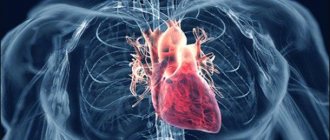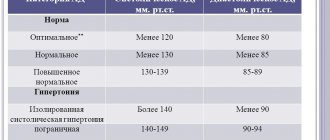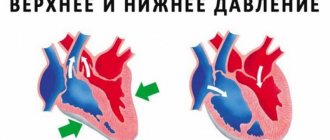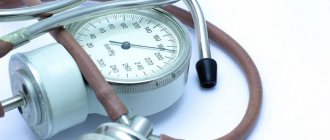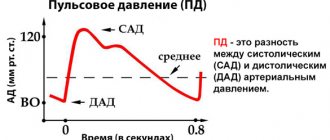Low lower pressure is a decrease in diastolic reading to 60 mmHg. Art. and less. It can be asymptomatic, then to normalize it is enough to change your lifestyle: sleep 8 hours, include vegetables, fruits, protein products, green tea in the diet, exercise, contrast shower.
If you experience dizziness, fainting, or constant weakness, you should consult a therapist to identify the cause of hypotension. Vitamins and tonics (ginseng, lemongrass) will help increase blood pressure. Constantly reduced levels impair the nutrition of the brain and heart, and the risk of memory loss and heart attack is higher. With an acute drop below 50 units there is a threat to life.
What indicators are we talking about and when can we talk about hypotension?
Diastolic hypotension does not always develop, even if external data suggests it.
Outdated ideas about the norm of 100 to 70 (at the lower limit) are no longer used in medical practice.
New standards from the World Health Organization are being applied, which allows for a reduction in the standard level. Fluctuations in the optimal value are within 10 mmHg.
Therefore, hypotension is considered to be lower pressure, below 60 mmHg (diastolic indicator).
Depending on the individual characteristics of the organism, the following indicators are distinguished:
- Low blood pressure. 60 mm Hg (lower blood pressure level).
- Hypotension of the first degree is below 60 mmHg, but above 50.
- Hypotension of the second or third degree. Below 50 mm.
- Critical hypotension. About 40 mmHg. It poses a danger to life and health. Cardiogenic shock, collapse and death of the patient are possible.
As already mentioned, the indicators are individual in nature and depend on the physiology of a particular person.
But the diastolic indicator should not drop below 60 mmHg. This is no longer normal. If your blood pressure drops, you should immediately consult a doctor.
What does low blood pressure mean?
Reduced lower blood pressure in most patients indicates weakness of the vascular wall. It is not elastic enough and does not maintain normal tone (total peripheral resistance is reduced). This change is a consequence of age-related changes, poisoning, infection, allergies and hormonal imbalance.
Low blood volume in the vascular bed is also possible. This is often a reaction to dehydration (diarrhea, vomiting, bleeding) or redistribution of blood - stagnation due to cardiac, venous insufficiency, effusion into the chest, abdominal cavity.
Low blood pressure may occur with heart failure
Physiological factors in the development of hypotension
Isolated arterial diastolic hypotension often develops for pathological reasons. But there is no need to write off natural, physiological ones either.
They are approached first and only then are they looked for for any disease. Physiological factors include:
- Long-term lack of nutrition or insufficient, meager diet. Representatives of the fairer sex with an obsession with losing body weight are especially prone to bad eating habits.
As a result of catabolism, fats are broken down and heat and energy are released. The body spends accumulated resources. When there is no fat left, your own muscle fibers are used.
Hypotension is associated both with the peculiarities of metabolic processes and with a lack of vitamins and organic acids: B12, folic acid, vitamin A, etc.
- Features of genetic material. If there was a relative in the family who suffered from low blood pressure, with a high probability such a feature will manifest itself in the phenotype and genotype of one or more descendants.
Moreover, it is not always the case that if an ancestor’s health was normal due to hypotension, the scenario will be repeated in children or grandchildren. All organisms are different.
- Long periods of physical labor. Hypotension develops especially often in athletes and workers of metallurgical enterprises. Heavy physical activity and difficult environmental conditions lead to the formation of adaptive mechanisms.
Such people can also be recognized by chronic bradycardia (pulse rate less than 60 beats per minute), which usually does not cause them any discomfort.
- Abuse of alcohol and tobacco products. How a particular body will react to the next dose of alcohol or nicotine - no one can say in advance. A common occurrence is hypertension. But this is not the only option.
- Insufficient consumption of table salt. Both an excess of this substance and a lack of sodium chloride salt are bad. We need to look for a balance in consuming “white poison”. Optimally 7 grams per day.
- Peak hormonal conditions, such as puberty, the menstrual cycle and pregnancy in the fairer sex, menopause in men and women.
- Elderly years, provided that the patient moves little or is completely bedridden.
- Acclimatization. For example, when moving to unusual living conditions. Including during the holiday period in warm countries. Easier to adapt to cold weather conditions.
There are many physiological factors. But pathological ones are many times more common. According to specialized studies, the ratio is 70% to 30%.
Treatment
Treatment is prescribed only after identifying the underlying cause of the disease. If low lower blood pressure is just one of the symptoms of the underlying disease, then therapy is prescribed for the underlying pathology and the pressure is corrected during therapy.
There are also general provisions for a hypotensive patient. Firstly, this is a lifestyle correction. This concept includes several aspects:
- Normalization of sleep and rest patterns. People with low blood pressure need more sleep to feel full and productive. It is even recommended to set aside time for naps during the day.
- Nutrition correction. A balanced diet and adequate water load will provide a full range of all substances necessary for good heart function, normal circulating blood volume and good vascular condition.
- Physical activity. The main cause of lower hypotension depends primarily on the tone of the vascular wall. Dynamic exercises will help normalize tone: walking, jogging, active team games, cycling, swimming. Do not forget that you should not overload the body. Loads must be increased gradually, preferably under the supervision of a trainer familiar with the basics of physical therapy. It is necessary to take into account the presence of contraindications.
- Hardening. A method of traditional folk medicine, which is also aimed at normalizing vascular tone. It should be introduced gradually. It's best to start with a contrast shower. In this case, the water temperature should initially differ by 2-3˚C, and then gradually increase the difference in degrees. Of course, contraindications must also be taken into account.
- Be in the fresh air more often, take more walks, go to the forest, park area, away from polluted city air. Hypotonic patients are recommended to sleep with an open window to correct their chronic hypoxia.
- Normalization of the emotional background. Avoid stressful and conflict situations.
Secondly, there is also an auxiliary drug correction based on herbal preparations: Eleutherococcus, Ginseng, Schisandra. Such generally accepted methods of correcting hypotension as drinks with high caffeine content, alcohol and chocolate are not recommended by official medicine.
Pathological factors
Low diastolic pressure develops for a whole group of reasons. Let's briefly outline them:
- Long-term, often uncontrolled or insufficiently thought-out use of antihypertensive drugs. The patient himself and his attending physician are to blame (medical errors are possible, especially if there was a short period of observation in the absence of correction of the therapeutic regimen).
- Severe intoxication of the patient's body. Often as a result of infectious diseases.
There is a direct correlation between the degree of hypotension and the nature of intoxication. The most difficult situation is the course of chronic infectious diseases such as tuberculosis.
The viral origin of the disease also plays a role, for example, in AIDS and other pathologies.
The reason lies in the irritation of special brain centers by waste products of infectious agents.
- Deficiency of several hormones in the body. A major role in the regulation of blood pressure is played by cortisol (substance of the adrenal cortex), T3, T4 (thyroid hormones), TSH, corticotropin (specific active elements of pituitary origin).
Also, partly, the hormone vasopressin. The list of possible organ diseases is very wide. Changes can also develop as a result of injuries and tumor processes.
- Another reason for low lower pressure is a lack of hemoglobin. In other words, anemia of various etiologies. Most often associated with insufficient iron in the blood.
In addition to low blood pressure, other symptoms are possible and even probable, such as perversion of taste preferences (a person may well eat chalk and inedible things), disorders of regenerative processes, etc. It's hard to miss a problem like this.
- Inflammatory processes in organs and tissues of a local and generalized nature.
- Avitaminosis, hypovitaminosis of various etiologies.
- Neoplastic processes in the body. Malignant tumors are always accompanied by severe hypotension, including isolated hypotension, of the diastolic type.
- Renal dysfunction. Including all kinds of nephropathies. Glomurulonephritis, pyelonephritis, nephritis, etc. Accompanied by a violation of the synthesis of prehormone-renin, which has a pronounced regulatory ability.
- Shock. Including anaphylactic. Associated with a drop in blood pressure to critical levels. An emergency condition that requires immediate medical attention.
- Stressful situations with ongoing processes of autonomic dysfunction.
- Bleeding. Including gynecological and gastroenterological. They lead to anemia, which is associated with a decrease in blood pressure.
It is necessary to determine the etiology of the process in order to prescribe adequate treatment. The causes of low diastolic pressure can be any. You can't figure it out on your own.
Danger and first aid
The level of blood supply to organs and tissues is determined by the state of the diastolic indicator. But if the lower pressure is 50, this indicates serious violations and requires timely assistance from a specialist.
Due to malnutrition, pathologies of the nervous system develop, memory and concentration deteriorate, and the endocrine system and kidneys are affected.
If you feel a pronounced loss of strength, then to stabilize your condition you need to drink a cup of strong tea or coffee, or a little ginger tea. But these drinks cannot be consumed constantly, as they disrupt the processes of self-regulation of blood pressure.
You can bring the vascular system back to normal with the help of a contrast shower. It is better to take it in the morning.
Rubbing the muscles of the feet, legs, and kneading the hands has a reflexogenic effect on vascular tone.
Also read: Types and stages of arterial hypertension
Is it possible to independently raise the lower pressure to normal levels?
It makes sense to try if both indicators: diastolic and systolic are low. Otherwise, it is not recommended to take risks.
The best option would be to adopt a horizontal position, lie quietly, breathe evenly and move less.
The following is the algorithm:
- Take one tonic tablet. Aspirin or Citramon will help.
- Drink a tonic drink, coffee or tea, one cup.
- Eat something salty, such as cucumber.
Contrast showers, baths and the like are not recommended. There will most likely be no consequences, but no effect either.
If there is no increase in indicators within 20 minutes, this is grounds for calling an ambulance.
Doctors will provide the necessary assistance on site and, most likely, will offer hospitalization in a specialized hospital for examination in specialized conditions.
To agree or not is the patient’s choice. If this is not possible, you should make an appointment with a cardiologist and, at the first convenient opportunity, visit a specialist to prescribe a course of treatment.
Stopping an attack is not enough.
What can you do at home?
There is little that can be done at home. All presented methods are designed to symmetrically increase both systolic and diastolic parameters, without signs of selectivity.
If there is a significant decrease in the level of upper blood pressure (less than 90 mm Hg) and you feel unwell, you should seek medical help. It's better to call an ambulance.
There is no need to be afraid of taking someone else’s place: doctors themselves rank the urgency of situations. Therefore, in Russia and the CIS countries, an ambulance is sometimes not an ambulance at all.
You can raise your upper blood pressure only with a combination of drugs with a clearly defined dosage, but without a doctor it is impossible to choose such a combination.
- Before the doctors arrive, you need to lie down and calm down. Breathing is slow, rhythmic. There is no need to panic. You can drink coffee, tea, or eat a salty product (for example, cucumber). An increase in performance should follow within 20 minutes. It is better to avoid taking pills; it is not known how taking them will affect the condition.
- Upon arrival of the doctor, you need to tell your own feelings. If necessary, the patient is taken to the hospital for further examination.
What symptoms should you see a doctor for?
Any controversial or suspicious manifestation is grounds for visiting a cardiology specialist.
There is, however, a certain list of symptoms for which consultation is simply necessary, and in special cases emergency medical care cannot be avoided.
Among them:
- Dizziness. Since lower pressure indicates the intensity of blood flow, it is logical that the cerebral structures do not receive enough nutrients and oxygen.
- Headache or cephalalgia of unknown origin that lasts for at least several days intermittently.
- Pulse disturbances such as tachycardia or bradycardia (accelerated over 90 beats per minute or slow rhythm, less than 60 beats per minute).
- Chest pain, radiating to the arms and shoulder blade.
- Nausea.
- Vomiting of an indomitable nature.
- Paleness of the skin.
- Cyanosis of the nasolabial triangle. Blue skin around the mouth.
- Darkening of the eyes as a result of sudden movements (orthostatic hypotension).
- Fainting conditions.
- Breathing disorders such as shortness of breath or even suffocation.
Moreover, you need to consult a doctor for more complex manifestations: confusion, inability to control muscles, etc.
Symptoms
A decrease in blood pressure always causes a person to feel a loss of strength and apathy.
The main symptoms include:
- constant desire to sleep;
- asthenia;
- pale skin;
- feeling of chills in the extremities;
- dizziness.
The severity of symptoms depends on the degree of deviation of blood pressure readings from the norm and on how destructive the changes have affected the vascular system.
With a slight decrease, headaches and a desire to constantly sleep appear.
When the value drops below 80, vomiting and nausea are added to the symptoms listed above.
What are the main consequences of isolated diastolic hypotension?
Among the adverse consequences of low blood pressure:
- Congestion in the circulatory system. The blood flow is weak, insufficient to nourish tissues and organs. The result is, among other things, the development of chronic heart failure with myocardial atrophy and further weakening of cardiac activity. Everything can end in a heart attack or ischemic stroke.
- Impaired cerebral circulation with the development of secondary encephalopathy. In addition, the risk of such a terrible condition as Alzheimer's disease increases. Or cyanide dementia.
- Heart attack or stroke as a result of insufficient blood circulation in the body. This has already been said.
- Cardiac ischemia.
- Fainting of a sudden nature with possible trauma to the patient in unfavorable conditions. Especially if syncope caught the patient on the street.
It is necessary to be thoroughly examined and undergo a course of specific treatment to ensure that there are no complications. Although it would be more accurate to talk about reducing risks.
Low lower (diastolic) pressure: causes, symptoms, diagnosis and treatment
Blood pressure is one of the main markers of vital functions in the human body. Any deviations from the norm indicate possible “breakdowns” in the human body. High blood pressure is the most common cause of concern, but there is no denying that low blood pressure can also cause life-threatening situations.
Upper pressure shows the work of the heart, namely with what force the left ventricle ejects blood from its cavity during systole (contraction), which is why it is also called systolic.
Lower pressure is an indicator of the condition of the vascular walls. It is this resistance that the vascular wall provides when blood moves through it during diastole (the heart muscle rests and the cavities are filled with a new portion of blood), which is why this pressure is also called diastolic.
The ideal blood pressure is considered to be 120/80 mm Hg. Art. However, this is not true for every person. There are so-called centile tables in which everyone can determine the optimal indicators for themselves in accordance with gender, age and height. Indicators that fall within the range from the 25th to the 95th percentile are considered normal. On average, according to centile tables, a lower pressure of 60 is a borderline value for diastolic hypotension.
The main mechanisms that influence diastolic blood pressure: the tone and elasticity of the vascular wall, the normal functioning of the heart muscle and an adequate volume of circulating blood.
Features of treatment
The most reasonable thing is to be hospitalized, but every patient has the right to refuse hospitalization. If this happens, the next step is to make an appointment with a cardiologist. When the lower pressure drops to 80/50 and below, it is dangerous because of its suddenness with an extremely negative outcome.
You should not do the following at home:
- taking a contrast shower is useless;
- sniff ammonia;
- splash cold water on your face;
- drink coffee with cognac;
- use alcohol tinctures.
Loss of elasticity in blood vessels threatens an unpredictable reaction to any sudden action.
The first step is to lie on your back, start breathing calmly, trying not to move. You can massage your earlobes to promote blood flow and improve blood circulation.
Prevention
In order to prevent pathological conditions characterized by low lower pressure, a healthy lifestyle and proper nutrition are recommended. The diet should include meat, potatoes, legumes, nuts, and dark chocolate. You need to sleep at least 8 hours a day and spend more time outdoors. Moderate physical activity, giving up bad habits, avoiding occupational hazards, and maintaining an adequate work and rest regime are recommended. It is useful to take a contrast shower, which helps strengthen the walls of blood vessels and improve immunity.
It is necessary to normalize the work and rest regime, get a good night's sleep, increase physical activity, and also normalize nutrition.
Traditional medicine
Traditional medicine recipes also help raise blood pressure at home. The simplest and most effective recipes include:
- Mulberry infusion. To prepare, take dry berries of the plant, pour 250 ml of boiling water and infuse. Then the infusion is strained through gauze folded in 3 layers. Take a third of a glass 3 times a day.
- Lemon with honey. This method will normalize blood pressure and immune function. Take 10 lemons, grate them and add 1 liter of water. Now the product is infused in the refrigerator for 3 days. Then 500 g of honey is added, mixed and put back in the refrigerator. Use the medicine 50 ml 3 times a day.
- The following mixture effectively increases blood pressure: 50 g of ground natural coffee beans, 500 g of honey and lemon juice. Mixes everything thoroughly. Take 5 g 2 hours after meals.
- 2 onions along with the husk are washed and 1 liter of water is poured in, and 100 g of sugar is added there. The preparation is boiled for 10 minutes over low heat. Drink half a glass of it per day. The product will help raise blood pressure and support immune function.
For astheno-neurotic syndrome, a course of nootropics is administered to improve the psycho-emotional state. Medicines fight lethargy, normalize work capacity and blood flow in the vessels of the brain. Such medications include:
What examinations need to be completed and in what order?
Diagnosis is carried out under the supervision of a cardiologist. Additional consultations with a neurologist, nephrologist and endocrinologist may be required.
Everything is decided at the discretion of the treating specialist; you need to trust the doctor.
Possible examinations include:
- General assessment of the condition through a conversation with the patient and anamnesis. This activity plays a significant role in early diagnosis.
- Pulse study.
- Assessing blood pressure levels using a tonometer.
- Daily Holter monitoring to study blood pressure levels over time.
- Electrocardiography and echoradiography. In competent hands, these are informative studies that make it possible to draw clear conclusions. Invasive techniques are possible.
- Angiography.
- Blood tests for various types of hormones.
- General and biochemical blood test.
- Encephalography.
- Assessment of neurological status.
- General urine examination.
All in all, this is enough and even more than that. The list of measures is determined by the doctor, based on the expected pathological process and its activity.
How to treat isolated diastolic hypotension?
Lower blood pressure can only be increased by eliminating the root cause of the pathological condition using drug therapy.
The list of drugs is selected by a medical specialist. Tonics are also used, but in strictly controlled dosages.
In extreme cases, they resort to surgery on the heart and blood vessels. This is a relatively rare measure, especially in young patients (not counting cases with organ defects).
It is important to change your lifestyle: move more, but do it right, eat normally, avoid stress, give up bad habits. The doctor gives specific recommendations based on the situation.
Drug treatment alone is not enough. A complex effect on the body is required. It will take effort on the part of the patient himself.
Reasons for decreased upper pressure
Why is the top pressure low? Blood pressure levels decrease for various reasons. Some of them are not dangerous to health, but such phenomena should not be left without attention. A decrease in indicators is not a reason for serious concern during pregnancy in the first trimester, excessive fatigue and sudden changes in weather.
Dangerous factors that cause changes in blood pressure include:
- Severe diseases of the cardiovascular system (cardiovascular system);
- Diabetes mellitus at any stage of development;
- Severe traumatic brain or spinal injuries;
- Poisoning from chemicals, foods or medications;
- Obesity at increased risk;
- Disturbances in the endocrine system.
Timely measures taken to eliminate the pathological condition will significantly reduce harm to the body and reduce the risk of complications to a minimum.
Low upper pressure readings can also be affected by weather conditions

